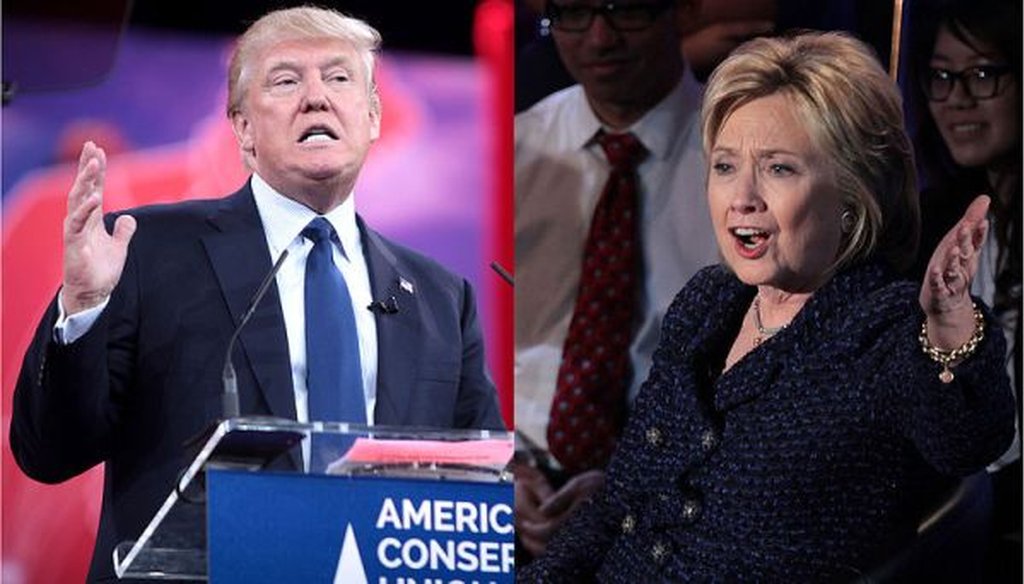Get PolitiFact in your inbox.

We compared Donald Trump and Hillary Clinton on their economic agendas. (Wikimedia Commons)
Editor's note: This is part of a series of stories comparing the candidates' positions on major policy issues.
The battle of economic agendas between Hillary Clinton and Donald Trump is a showdown of wonk vs. CEO.
Clinton has literally decades of experience in the domestic and international policy trenches. Befitting this background, she has offered a wide range of detailed proposals on everything from renewable energy goals to sick-leave guarantees. The issues page of her campaign website lists no fewer than 32 topic headings, some as specific as Alzheimer’s disease and animal welfare.
By contrast, Trump is a novice in electoral politics but an experienced CEO. He has offered specifics on a few issues, such as taxes and trade, but for the most part, Trump’s web pages on the issues offer broad statements rather than details.
Perhaps more noteworthy, experts said, is Trump’s willingness to shift his views over time, even from interview to interview.
Over her long political career, Clinton has racked up her share of flip-flops, most recently on the international trade deal known as the Trans-Pacific Partnership. But Trump sometimes reverses positions within days, or minutes. We’ve parsed his confusing comments on such important policy issues as whether the minimum wage should be increased, whether wealthier Americans should pay more in taxes, and whether he might renegotiate the U.S. debt if he became president.
"When he’s pressed about what his plan is, he’ll say, ‘Well, that’s a starting point,’ " said Roberton Williams, a fellow at the Urban Institute-Brookings Institution Tax Policy Center.
Still, observers say the highlights of both candidates’ policy views do communicate broad themes about how Clinton and Trump would approach economic policy.
Trump has been "pretty consistent about three big economic policy items," said Gary Burtless, an economist with the Brookings Institution. The first, he said, is to raise barriers to immigration. The second is to impose potentially large tariffs on goods from Mexico and China. And the third is to enact large tax cuts.
Clinton proposes a fairly cautious agenda -- one that offers a measure of change, but without blowing up the existing system and without bucking longstanding practices such as staying within budget constraints.
On taxes, "the Clinton plan is pretty much Obama extended," Williams said. "On the whole, she proposes a fairly small increase in taxes that would be borne almost entirely by the wealthy." Her plan would increase revenues collected by $1.1 trillion over 10 years, according to the Tax Policy Center’s modeling.
By contrast, Trump’s across-the-board tax cuts would represent a far bigger change than Clinton’s proposal. It would lower revenues over 10 years by a whopping $9.6 trillion, according to the Tax Policy Center’s analysis.
"He says economic growth and cuts would make up for that, but it’s hard to imagine that it would be possible to do so," Williams said.
Burtless agreed, saying he’s "very skeptical the effects growth will be more than a small percentage of the amount Trump has claimed."
They got support on June 17 from Moody’s Analytics, an economic research and data-services firm that examined Trump’s policies on taxes, government spending, immigration and international trade. Moody’s concluded that Trump’s proposals would make the U.S. economy less global and would substantially increase the federal debt, benefit the wealthy disproportionately, and push unemployment up. (Moody’s has said it will release a similar analysis of Clinton’s plan but has yet to do so.)
One of the clearest policy contrasts between the two candidates involves energy: Clinton seeks to wean the United States from fossil fuels by setting targets for renewable energy, while Trump wants to aggressively revitalize the flagging domestic oil and gas sector.
On the other hand, one area of convergence between Clinton and Trump are issues of interest to blue-collar Americans -- a demographic that includes some Bernie Sanders supporters who may be up for grabs in the general election.
Both Clinton and Trump have urged increased spending on infrastructure and have advocated policies that help rebuild the nation’s manufacturing sector, though Clinton has offered greater policy and budgetary specifics.
And while Trump has made getting tough on the United States’ foreign trading partners one of the centerpieces of his campaign, Clinton has moved away from her longstanding support for free trade, particularly as a result of her tough primary fight against Sanders. When she and Sanders appeared together for a unity event July 12, Clinton said, "We're going to say no to attacks on working families and no to bad trade deals and unfair trade practices, including the Trans- Pacific Partnership."
Issue
Clinton
Trump
Taxes
Would largely maintain the current tax code, with some increases for wealthier taxpayers.
Proposes across-the-board tax cut, with large cuts for wealthier taxpayers.
Minimum wage
Would increase nationally to $12, with $15 in some locations.
Has said he does not support a federal minimum wage but wants states to set their own minimum wages.
Trans-Pacific Partnership
After once helping negotiate the deal, she has since expressed skepticism.
Has come out forcefully against the trade agreement.
Manufacturing sector
Worker retraining
Enhance worker retraining options, such as a tax credit for businesses of $1,500 per apprentice.
No public stance.
Infrastructure
Supports infrastructure expansion but hasn’t offered funding details.
Energy development
Promises to revive the U.S. fossil-fuel sector, including by reducing regulations.
Science and technology
No public stance.
Income inequality
Has offered few details beyond his tax plan and a comment critical of CEO pay.
Wall Street regulation
Has said he would dismantle Dodd-Frank.
Small business
Would ease regulatory burdens on community banks and support innovative financing methods.
Has sharply criticized government regulation but has not proposed specific policies.
Policies for working families
Advocates equal pay, paid family leave, earned sick days, and expanded child care.
No public stance.
Our Sources
Hillary Clinton issues page, accessed July 11, 2016
Donald Trump positions page, accessed July 11, 2016
Donald Trump issues page, accessed July 11, 2016
Donald Trump, "An America First Energy Plan," May 26, 2016
Moody's Analytics, "The Macroeconomic Consequences of Mr. Trump’s Economic Policies," June 17, 2016
Washington Post, "The Trump campaign’s ‘issues’ page is completely amazing," July 6, 2016
Democrat and Chronicle, "15 Donald Trump 'wins' in 50 seconds," April 12, 2016
CBS News, "Donald Trump on CEO pay: It's a 'complete joke,' " Sept. 13, 2015
Reuters, "Donald Trump Says He Would Dismantle Dodd-Frank Wall Street Regulation," May 18, 2016
Politico, "Full transcript: Donald Trump's jobs plan speech," June 28, 2016
PolitiFact, "Hillary Clinton flip-flops on Trans-Pacific Partnership," Oct. 8, 2015
PolitiFact, "17 times Donald Trump said one thing and then denied it," July 6, 2016
PolitiFact, "Trying to pin down what Donald Trump thinks about abortion, the minimum wage, taxes, and U.S. debt," May 11, 2016
PolitiFact, "Donald Trump has floated big tariffs. What could the impact be?" June 21, 2016
PolitiFact, "Hillary Clinton correct that analysts have called Donald Trump a top global economic risk," June 27, 2016
PolitiFact, "PolitiFact's guide to the 2016 presidential candidate tax plans," April 7, 2016
Email interview with Gary Burtless, senior fellow with the Brookings Institution, July 7, 2016
Interview with Roberton Williams, fellow at the Urban Institute-Brookings Institution Tax Policy Center, July 7, 2016








































